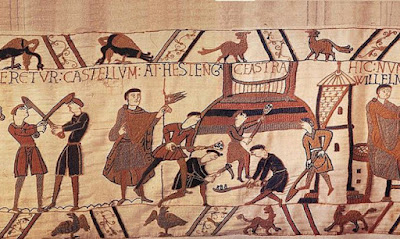Peveril's Arse

The military mind-set of William the Conqueror was obvious from the start. The first thing he did on landing his army on the south coast of England was to build a castle. The Chronicle of Battel Abbey reports, "The duke...did not long remain in that place, but went away to a port not far distant called Hastings, and there, having secured an appropriate place, he speedily built a castle of wood." His initial act of castle-building is captured on the Bayeux Tapestry . The Latin inscription reads, "This man has commanded that a fortification should be thrown up at Hastings". The scene is of a 'motte and bailey' castle in the making. Men with spades pile up a defensive mound of dirt. A wooden structure appears on top. The motte was an artificial hill, constructed by piling consecutive layers of earth and stones, compacting each one before laying the next. Sides were steep and covered with clay to deter attackers. A timber tower was erected on the flattened area


